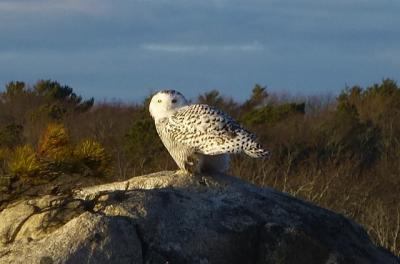Snowy owl ‘irruption’ comes to Marion
Local bird watchers are all atwitter this season as larger than normal numbers of the majestic snowy owl have landed on South Coast shores.
Known as an “irruption,” the arctic avians came south seeking food due to a boost in populations up north, said Jamie Bogart, research associate at the Dartmouth-based Lloyd Center for the Environment.
Bill and Tinker Saltonstsall spotted a snowy owl in the area of the Kittansett Club on Sunday while walking their dog, Bosun.
“Lo and behold Bosun was tearing around having a usual good romp. He flushed out one of those,” said Tinker, whose sighting is one of many this season from Rhode Island to Wareham.
A birder, Tinker said she has traveled to nearby areas such as Plymouth Beach with Mass Audubon to catch glimpses of the snowy owl.
“I was thrilled to see it,” she said. “It always gives me a huge leap of my heart. They’re so beautiful.”
The birds’ white feathers make them much easier to spot than many owls. And unlike the more common “night owl” species, snowy owls are diurnal, meaning they’re awake during the daytime.
That comes in pretty handy considering their tundra habitats have up to 24 hours of daylight during certain seasons.
The large owls are also easy to spot because they flock to flat, open areas comparable to the tundra. According to the Lloyd Center’s website, “snowy owls winter in open areas and can be found on rocks, dunes, grasslands and near-ground structures such as fence posts.”
There's plenty of time to go looking for the owls. Bogart said the birds may stick around as long as early March.
He also said that, while the birds are fairly irresistible, people should refrain from hooting (ahem), hollering and harassing them.
“Just like anything – shore birds on the beaches, a seal that comes ashore – everyone is interested and chasing them around with cameras like I am,” said Bogart. “Take a picture but don’t go chasing them down.”















